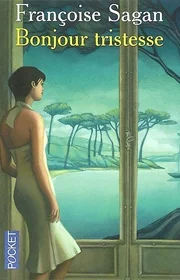
“Bonjour Tristesse” follows the story of Cécile, a young girl spending a carefree summer on the French Riviera with her father and his girlfriend, Anne. The idyllic atmosphere takes a turn when Cécile becomes determined to disrupt the relationship between her father and Anne. As emotions unravel, the novel explores themes of love, jealousy, and the consequences of impulsive actions, all set against the beautiful backdrop of the Mediterranean. Françoise Sagan’s work captures the complexities of relationships and the poignant nuances of adolescence.
Read Bonjour Tristesse Flipbook:
Listen to Bonjour Tristesse Audiobook:
Title: Bonjour Tristesse
Author: Françoise Sagan
Publication Year: 1954
Genre: Coming-of-age novel, drama
Setting: French Riviera
Main Characters:
• Cécile: Protagonist and narrator, a young girl
• Anne: Cécile’s father’s girlfriend
• Raymond: Cécile’s father
Plot Summary:
• The story revolves around Cécile, who is spending a carefree summer on the French Riviera with her father and his girlfriend, Anne.
• Cécile’s idyllic life takes a turn when Anne disrupts their dynamic, and Cécile becomes determined to sabotage Anne’s relationship with her father.
• The narrative explores themes of love, jealousy, and the complexities of relationships.
Style:
• Sagan’s writing is concise and evocative, capturing the emotions of the characters.
• The novel is known for its exploration of existentialist themes.
Impact:
• Bonjour Tristesse gained immediate popularity and was considered scandalous for its portrayal of teenage rebellion and unconventional relationships.
• It established Françoise Sagan as a prominent French writer, and she became a literary sensation at a young age.
Legacy:
• The novel remains a classic of French literature and is often studied in literature courses.
• It has been adapted into film and stage productions.
Young Author: Françoise Sagan wrote “Bonjour Tristesse” at the age of 17, making her a literary sensation with her debut novel.
Overnight Success: The novel was an instant success upon its publication in 1954, selling thousands of copies within days and propelling Sagan to fame.
Title Meaning: “Bonjour Tristesse” translates to “Hello, Sadness” in English. The title reflects the book’s exploration of emotional complexities and the melancholic aspects of life.
Controversial Themes: The novel sparked controversy for its portrayal of teenage rebellion, unconventional relationships, and the questioning of societal norms, challenging the moral standards of the time.
Film Adaptation: In 1958, the book was adapted into a film directed by Otto Preminger, bringing the story to the big screen and reaching a wider audience.
Existentialist Influence: Sagan’s writing in “Bonjour Tristesse” is influenced by existentialist philosophy, exploring the existential dilemmas faced by the characters.
Global Impact: The novel was not only a success in France but also gained international acclaim, further establishing Sagan as a prominent figure in literature.
Cultural Icon: “Bonjour Tristesse” remains an enduring classic, often studied in literature courses for its exploration of human emotions and relationships.
Pseudonym Use: Françoise Sagan was a pen name; the author’s real name was Françoise Quoirez. She chose the pseudonym for her literary career.
Literary Legacy: The success of “Bonjour Tristesse” set the stage for Sagan’s prolific career, and she went on to write several more novels and plays, solidifying her place in French literature.